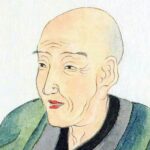
Katsushika Hokusai
Japanese, 1760–1849
Fuji Seen from the Katakura Tea Plantation in the Suruga Province, 1830–32 ca.
color woodblock print
10 × 14¾ in.
Santa Barbara Museum of Art, lent by Janet Way Vlasach

Keisai Eisen, Portrait of Hokusai (detail), 1848
"All my work is based to some extent on Japanese art ... Japanese art, in decline in its own country, is taking new roots among French Impressionist artists. It’s this practical side for artists that necessarily interests me — more than the trade in japonaiseries." - Letter to Theo, 15 July 1888
COMMENTS
When, in the 1850s, after more than two centuries of isolation, Japan opened to international trade, a plethora of Japanese goods began to be imported into France, and a bonafide craze for all things Japanese was born. A vogue for interior decoration in the Japanese manner gripped the bourgeoisie, and department stores began offering Japanese porcelain, lacquerware, parasols, screens, fans, lanterns, trinkets, and objets d’art.
Artists, meanwhile, were infatuated with Japanese woodblock prints – in 1880, the French novelist Emile Zola observed that any artist worth his salt studied Japanese prints, “which everyone has nowadays”. Indeed, some artists, including Claude Monet and James McNeill Whistler, had been collecting so-called ‘ukiyo-e’ (pictures of the floating world) prints for years. Already by 1872, the French term ‘Japonisme’ had been coined, to describe the influence of Japanese art and design on Western culture, especially the visual arts.
In a sense, then, Van Gogh was late to the ‘Japonisme’ party: he first became attuned to the beauty of Japanese art while living in Antwerp in 1885, when he pinned a set of black-and-white prints to his studio wall, a year or so before he moved in with his brother, Theo, in Paris, then the center of modernity. Stimulated, though, by discussions of Japanese art in journals, magazines and novels, his infatuation quickly grew …
The impact of Japanese prints upon Van Gogh’s painting during this period is well known. In 1887, he made several copies of prints by Japanese artists, including, first, a pretty view of plum trees, and then another scene, this time depicting people scurrying beneath umbrellas along a bridge during an evening shower, both by Utagawa Hiroshige (1797-1858). He also made a painting of a Japanese courtesan wearing a splendid kimono, which he copied from the cover of a magazine, and two portraits of the shopkeeper and paint dealer Julien ‘Père’ Tanguy, sitting against a flat, almost visually overwhelming background of colorful Japanese prints …
Rather than simply continuing to copy Japanese prints, though, Van Gogh began experimenting with aspects of them in his own paintings, including the use of bright, flat colors and strong diagonals, close-up and bird’s-eye views, unconventional cropping, the omission of the horizon, and the isolation of prominent objects, such as large cut-off tree trunks, in the foreground. Inspired by the natural world, he painted flowers, including, on several memorable occasions, irises – comparing one of these springtime views to “a Japanese dream” …
In the summer of 1888, Van Gogh even depicted himself in a self-portrait as “a bonze”, as he put it in a letter to Gauguin, “a simple worshipper of the eternal Buddha”, i.e., a Japanese monk, with a shaved head. Meanwhile, in his famous Self-Portrait with Bandaged Ear (1889), from the Courtauld Gallery in London, he included his favorite Japanese ‘crépon’ (i.e., a print on wrinkled paper, like crêpe), depicting geishas in a landscape, on the wall behind his head.
It offers an optimistic note in an otherwise melancholic scene, as Van Gogh presents himself in a hat and overcoat, muffled up against the cold in his studio, with a blank canvas on the easel, after returning home from hospital having mutilated his own ear during a fit of insanity. Less than five months after that first breakdown, in December 1888, he was admitted to a mental asylum in Saint-Rémy-de-Provence, in May 1889.
Referring to the Courtauld’s painting, which has traveled to Amsterdam, Bakker explains: “He’s ill, Gauguin has left, and he has to start anew. And this print, with its beautiful, colorful world of nature and women, symbolizes his enduring love for Japanese art. It represents his dream of the South as a painter’s paradise.”
- Alastair Sooke, Van Gogh and Japan: the prints that shaped the artist, BBC Culture, 2018
https://www.bbc.com/culture/article/20180611-van-gogh-and-japan-the-prints-that-shaped-the-artist
SBMA CURATORIAL LABELS
These three ukiyo-e (which translates to “floating-world pictures”) woodblock prints are typical of the kinds of images that were so influential for several generations of avant-garde art, particularly in France. They demonstrate many of the properties that artists like Van Gogh readily adapted to replace the conventions of Western illusionism (the type of representational painting propagated by the Academy since the Renaissance). All three utilize the bright hues that Van Gogh attempted to bring into his own painting, especially after moving to Arles. In the Hiroshige, we see the motif of pine trees brought dramatically close up in the foreground, in comparison to the rapid recession implied by the zigzag of lapping waves on the shore (not dissimilar to Vincent’s pine trees in St. Rémy in the painting nearby). In the Kunisada print, we see the flattening effect of the figure’s patterned robe, which, along with the running-script calligraphy, assert the flatness of the image surface. Such flourishes of line find their counterpart in Vincent’s etching of Dr. Gachet, on view nearby. Finally, in the Hokusai landscape of Mt. Fuji, we see the elevated perspective, oblivious to the laws of Western one-point perspective, in which up is back and the relative visibility of the compositional elements, no matter their spatial relation, remains consistent throughout. In some of Van Gogh’s most brilliant landscape inventions, the presence of Hokusai’s example can be clearly felt.
- Through Vincent's Eyes, 2022
